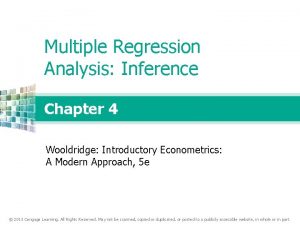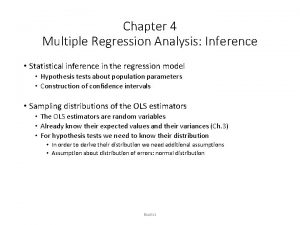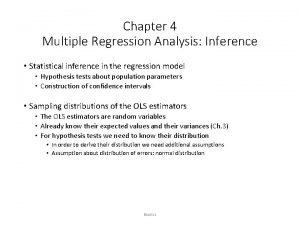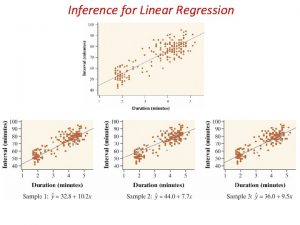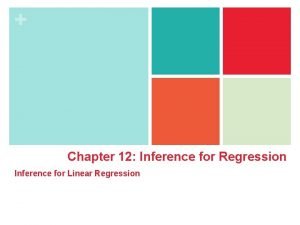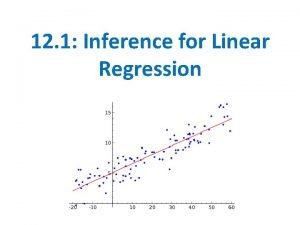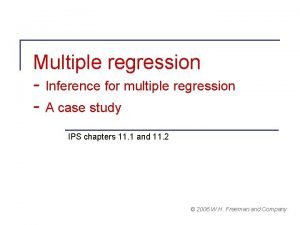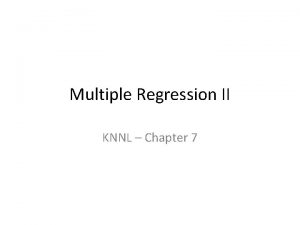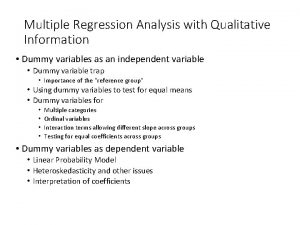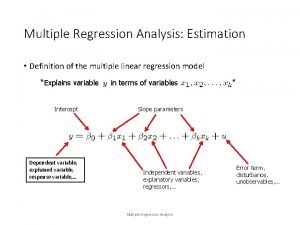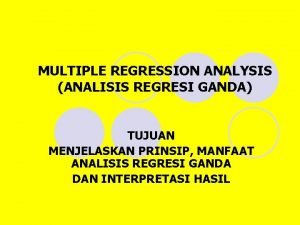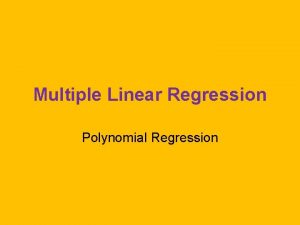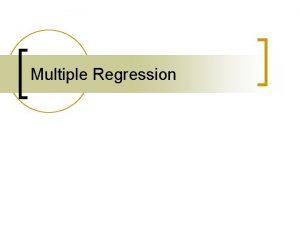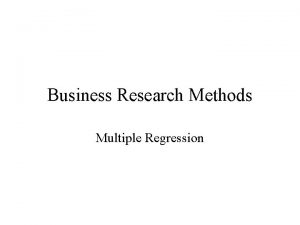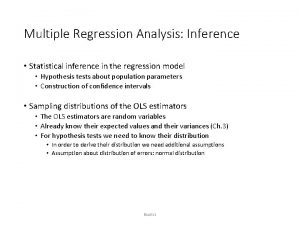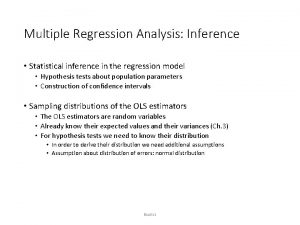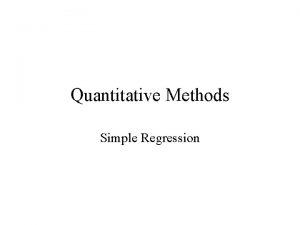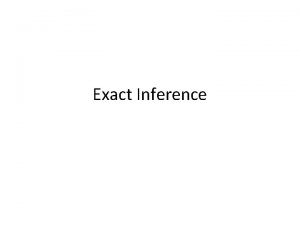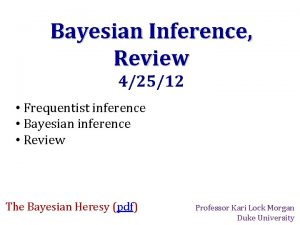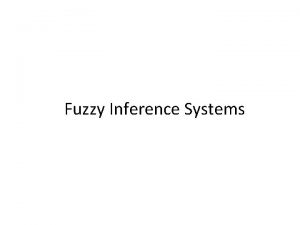Multiple regression Inference for multiple regression A case



















- Slides: 19

Multiple regression - Inference for multiple regression - A case study IPS chapters 11. 1 and 11. 2 © 2006 W. H. Freeman and Company

Objectives (IPS chapters 11. 1 and 11. 2) Multiple regression p Multiple linear regression model p Confidence interval for βj p Significance test for βj p Anova F-test for multiple regression p Squared multiple correlation R 2

Multiple linear regression model For p explanatory variables, we can express the y-values y = 0 + 1 x 1 … + pxp+e e is an error which is difference between each y-value and its mean. The statistical model for the sample data (i = 1, 2, … n) is then: Data = fit yi = b 0 + b 1 x 1 i … + bpxpi + + residual ei The parameters of the model are 0, 1 … p and . Where s is the standard deviation of the errors, e

We selected a random sample of n individuals for which p + 1 variables were measured (x 1 … , xp, y). The least-squares regression method minimizes the sum of squared deviations, ei 2 (= yi – ŷi)2 to express y as a linear function of the explanatory variables: ŷi = b 0 + b 1 x 1 i … + bkxpi ■ As with simple linear regression, the constant b 0 is the y intercept. ■ The regression coefficients (b 1… bp) reflect the change in y for a 1 unit change in each independent variable. They are analogous to the slope in simple regression. y ŷ b 0 bp are unbiased estimates of population parameters β 0 βp

Confidence interval for βj Estimating the regression parameters β 0, … βj … βp is a case of onesample inference with unknown population variance. We use the t distribution, with n – p – 1 degrees of freedom. A level C confidence interval for βj is given by: bj ± t* SEbj - SEbj is the standard error of bj. - t* is the critical t for the t (n – 2) distribution with area C between –t* and +t*.

Significance test for βj To test the hypothesis H 0: j = 0 versus a 1 or 2 sided alternative. We calculate the t statistic which has the t (n – p – 1) null distribution to find the p-value of the test. t = bj/SEbj

ANOVA F-test for multiple regression For a multiple linear relationship ANOVA tests the hypotheses H 0 : β 1 = β 2 = … = β p = 0 versus Ha: H 0 not true by computing the F statistic: F = MSM / MSE When H 0 is true, F follows the F(1, n − p − 1) distribution. The p-value is P(> F). A significant p-value doesn’t mean that all the explanatory variables have a significant influence on y — only that at least one of them does.

ANOVA table for multiple regression Source Sum of squares SS df Mean square MS F P-value Model p SSG/DFG MSG/MSE Tail area above F Error n−p− 1 SSE/DFE Total n− 1 SST = SSM + SSE DFT = DFM + DFE The standard deviation of the sampling distribution, s, for n sample data points is calculated from the residuals ei = yi – ŷi s is an unbiased estimate of the regression standard deviation σ.

Squared multiple correlation R 2 Just as with simple linear regression, R 2, the squared multiple correlation, is the proportion of the variation in the response variable y that is explained by the model. In the particular case of multiple linear regression, the model is a linear function of all p explanatory variables taken together.

We have data on 224 first-year computer science majors at a large university in a given year. The data for each student include: * Cumulative GPA after 2 semesters at the university (y, response variable) * SAT math score (SATM, x 1, explanatory variable) * SAT verbal score (SATV, x 2, explanatory variable) * Average high school grade in math (HSM, x 3, explanatory variable) * Average high school grade in science (HSS, x 4, explanatory variable) * Average high school grade in English (HSE, x 5, explanatory variable) Here are the summary statistics for these data given by software SAS:

The first step in multiple linear regression is to study all pair-wise relationships between the p + 1 variables. Here is the SAS output for all pair-wise correlation analyses (value of r and 2 sided p-value of H 0: ρ = 0). Scatterplots for all 15 pair-wise relationships are also necessary to understand the data.

For simplicity, let’s first run a multiple linear regression using only the three high school grade averages: P-value very significant R 2 is fairly small (20%) HSM significant HSS, HSE not

P-value very significant R 2 is fairly small (20%) The ANOVA for the multiple linear regression using only HSM, HSS, and HSE is very significant at least one of the regression coefficients is significantly different from zero. But R 2 is fairly small (0. 205) only about 20% of the variation in cumulative GPA can be explained by these high school scores. (Remember, a small p-value does not imply a large effect. )

HSM significant HSS, HSE not The tests of hypotheses for each b within the multiple linear regression reach significance for HSM only. We found a significant correlation between HSS and GPA when analyzed by themselves, so why isn’t b. HSS significant in the multiple regression equation? HHS and HHM are also significantly correlated suggesting redundancy. If all 3 high school averages are used, neither HSE or HSS, significantly helps us predict GPA over and above what HSM does all by itself.

We now drop the least significant variable from the previous model: HSS. P-value very significant R 2 is small (20%) HSM significant HSE not The conclusions are about the same. But notice that the actual regression coefficients have changed.

Let’s run a multiple linear regression with the two SAT scores only. P-value very significant R 2 is very small (6%) SATM significant SATV not The ANOVA test for βSATM and βSATV is very significant at least one is not zero. R 2 is really small (0. 06) only 6% of GPA variations are explained by these tests. When taken together, only SATM is a significant predictor of GPA (P 0. 0007).

We finally run a multiple regression model with all the variables together P-value very significant R 2 fairly small (21%) HSM significant The overall test is significant, but only the average high school math score (HSM) makes a significant contribution in this model to predicting the cumulative GPA. This conclusion applies to computer majors at this large university.


Warnings p Multiple regression is a dangerous tool. The significance or nonsignificance of any one predictor in a multiple predictor model is largely a function of what other predictors may or may not be included in the model. p P-values arrived at after a selection process (where we drop seemingly unimportant X’s) don’t mean the same thing as P-values do in earlier parts of the textbook. p When the X’s are highly correlated (with each other) two equations with very different parameters can yield very similar predictions (so interpreting slopes as “if I change X by 1 unit, I will change Y by b units” may not be a good idea.
 Multiple regression analysis inference
Multiple regression analysis inference Multiple regression analysis inference
Multiple regression analysis inference Multiple regression analysis inference
Multiple regression analysis inference Simple linear regression and multiple regression
Simple linear regression and multiple regression Regression linear model
Regression linear model Best worst and average case
Best worst and average case Conditions for linear regression inference
Conditions for linear regression inference Conditions for inference regression
Conditions for inference regression Standard error of slope formula
Standard error of slope formula Logistic regression vs linear regression
Logistic regression vs linear regression Logistic regression vs linear regression
Logistic regression vs linear regression Linear trend equation
Linear trend equation Confidence interval multiple regression
Confidence interval multiple regression Extra sum of squares multiple regression
Extra sum of squares multiple regression Multiple regression analysis with qualitative information
Multiple regression analysis with qualitative information Explanatory variable definition
Explanatory variable definition Dataset for regression analysis
Dataset for regression analysis Multiple regression analysis adalah
Multiple regression analysis adalah Polynomial regression multiple variables
Polynomial regression multiple variables Linear regression multiple features
Linear regression multiple features
